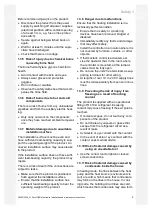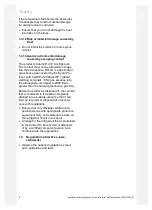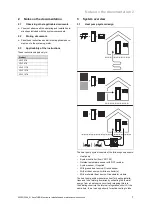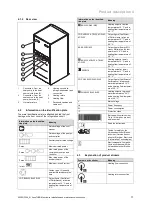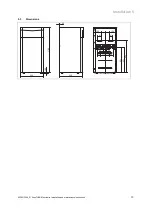
Filling and purging the system 7
0020213394_01 flexoTHERM exclusive Installation and maintenance instructions
17
6.2
Connecting the heat pump to the heating
circuit
Caution.
Risk of damage from magnetite deposits.
In heating installations with steel pipes,
static heating surfaces and/or buffer cylinder
systems, magnetite may form where large
volumes of water are involved.
▶
Insert a magnetite filter to protect the
pump inside the product.
▶
You must position the filter in direct prox-
imity to the return line to the heat pump.
1.
Install a diaphragm expansion tank at the heat pump
connection provided.
2.
Install an expansion relief valve (at least DN 20, open-
ing pressure of 3 bar) with pressure gauge.
3.
Install the expansion relief valve hose in a frost-free
environment and ensure that its routing ends in an open
tundish where it is then visible.
4.
Install an air/dust separator in the return of the heating
circuit.
5.
Connect the heating flow to the heating flow connection
of the heat pump.
6.
Connect the heating return to the heating return con-
nection of the heat pump.
7.
Insulate all of the pipes in the heating circuit and the
connections for the heat pump so that they are vapour-
diffusion-tight in order to prevent them from falling be-
low the dew point in cooling mode.
6.3
Connecting the heat pump to the brine
circuit
29
71
≥100 mm
42a
65
A
B
29
Brine pump
42a
Brine expansion relief
valve
65
Brine collecting con-
tainer
71
Brine diaphragm expan-
sion tank
A
From the heat source
to the heat pump (hot
brine)
B
From the heat pump to
the heat source (cold
brine)
1.
Remove the blind caps from the brine connections.
These are no longer required and can be properly dis-
posed of.
2.
Connect the brine lines to the heat pump.
3.
Insulate all of the brine lines and the connections of the
heat pump so that they are vapour-diffusion-tight.
Note
Vaillant recommends that you install the
Vaillant heat pump brine filling unit (not
required when installing the groundwater
module). By doing this, it is then possible to
carry out a preparatory partial bleed of the
brine circuit, e. g. the flow and return lines of
the brine circuit to the product.
6.4
Hydraulic wiring in the system
6.4.1
Installing heating circuits with direct
connection
1.
Install the hydraulic components in accordance with
the local requirements as shown in the system diagram
example,
→
Installation instructions for the system.
2.
Connect the underfloor heating circuits or heating circuit
distributors directly to the heat pump.
3.
Connect a limit thermostat to ensure that the heat
pump's underfloor protection works correctly.
(
→
Page 22)
4.
Ensure that a minimum volume of circulating water is
guaranteed.
–
Minimum volume of circulating water: 35% of the
nominal flow
6.4.2
Installing heating circuits with direct
connection and domestic hot water cylinder
1.
Install the heating circuits for direct operation.
(
→
Page 17)
2.
Secure the temperature sensor (VR10), available from
the range of accessories, in the domestic hot water
cylinder and connect it to the heat pump.
7
Filling and purging the system
7.1
Filling and purging the heating circuit
7.1.1
Checking and treating the heating
water/filling and supplementary water
Caution.
Risk of material damage due to poor-qual-
ity heating water
▶
Ensure that the heating water is of suffi-
cient quality.
▶
Before filling or topping up the system, check the quality
of the heating water.
Checking the quality of the heating water
▶
Remove a little water from the heating circuit.
▶
Check the appearance of the heating water.
▶
If you ascertain that it contains sedimentary materials,
you must desludge the system.
▶
Use a magnetic rod to check whether it contains mag-
netite (iron oxide).



